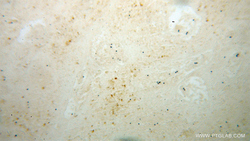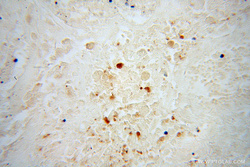Antibody data
- Antibody Data
- Antigen structure
- References [11]
- Comments [0]
- Validations
- Western blot [1]
- Immunohistochemistry [2]
Submit
Validation data
Reference
Comment
Report error
- Product number
- 14647-1-AP - Provider product page

- Provider
- Proteintech Group
- Proper citation
- Proteintech Cat#14647-1-AP, RRID:AB_2243396
- Product name
- BIN1 antibody
- Antibody type
- Polyclonal
- Description
- KD/KO validated BIN1 antibody (Cat. #14647-1-AP) is a rabbit polyclonal antibody that shows reactivity with human, mouse, rat and has been validated for the following applications: IHC, IP, WB,ELISA.
- Reactivity
- Human, Mouse, Rat
- Host
- Rabbit
- Conjugate
- Unconjugated
- Isotype
- IgG
- Vial size
- 20ul, 150ul
Submitted references The role of Limch1 alternative splicing in skeletal muscle function.
Small and Large Extracellular Vesicles Derived from Pleural Mesothelioma Cell Lines Offer Biomarker Potential.
BIN1 is a key regulator of proinflammatory and neurodegeneration-related activation in microglia.
Long non-coding RNA SNHG10 upregulates BIN1 to suppress the tumorigenesis and epithelial-mesenchymal transition of epithelial ovarian cancer via sponging miR-200a-3p.
Fractional anisotropy from diffusion tensor imaging correlates with acute astrocyte and myelin swelling in neonatal swine models of excitotoxic and hypoxic-ischemic brain injury.
Combining Hypothermia and Oleuropein Subacutely Protects Subcortical White Matter in a Swine Model of Neonatal Hypoxic-Ischemic Encephalopathy.
Salinomycin promotes T-cell proliferation by inhibiting the expression and enzymatic activity of immunosuppressive indoleamine-2,3-dioxygenase in human breast cancer cells.
Neuronal BIN1 Regulates Presynaptic Neurotransmitter Release and Memory Consolidation.
Reduction of the expression of the late-onset Alzheimer's disease (AD) risk-factor BIN1 does not affect amyloid pathology in an AD mouse model.
Low expression of Bin1, along with high expression of IDO in tumor tissue and draining lymph nodes, are predictors of poor prognosis for esophageal squamous cell cancer patients.
Cooperation of MICAL-L1, syndapin2, and phosphatidic acid in tubular recycling endosome biogenesis.
Penna MS, Hu RC, Rodney GG, Cooper TA
Life science alliance 2023 Jun;6(6)
Life science alliance 2023 Jun;6(6)
Small and Large Extracellular Vesicles Derived from Pleural Mesothelioma Cell Lines Offer Biomarker Potential.
Ahmadzada T, Vijayan A, Vafaee F, Azimi A, Reid G, Clarke S, Kao S, Grau GE, Hosseini-Beheshti E
Cancers 2023 Apr 18;15(8)
Cancers 2023 Apr 18;15(8)
BIN1 is a key regulator of proinflammatory and neurodegeneration-related activation in microglia.
Sudwarts A, Ramesha S, Gao T, Ponnusamy M, Wang S, Hansen M, Kozlova A, Bitarafan S, Kumar P, Beaulieu-Abdelahad D, Zhang X, Collier L, Szekeres C, Wood LB, Duan J, Thinakaran G, Rangaraju S
Molecular neurodegeneration 2022 May 7;17(1):33
Molecular neurodegeneration 2022 May 7;17(1):33
Long non-coding RNA SNHG10 upregulates BIN1 to suppress the tumorigenesis and epithelial-mesenchymal transition of epithelial ovarian cancer via sponging miR-200a-3p.
Lv W, Jia Y, Wang J, Duan Y, Wang X, Liu T, Hao S, Liu L
Cell death discovery 2022 Feb 11;8(1):60
Cell death discovery 2022 Feb 11;8(1):60
Fractional anisotropy from diffusion tensor imaging correlates with acute astrocyte and myelin swelling in neonatal swine models of excitotoxic and hypoxic-ischemic brain injury.
Lee JK, Liu D, Jiang D, Kulikowicz E, Tekes A, Liu P, Qin Q, Koehler RC, Aggarwal M, Zhang J, Martin LJ
The Journal of comparative neurology 2021 Jul 1;529(10):2750-2770
The Journal of comparative neurology 2021 Jul 1;529(10):2750-2770
Combining Hypothermia and Oleuropein Subacutely Protects Subcortical White Matter in a Swine Model of Neonatal Hypoxic-Ischemic Encephalopathy.
Lee JK, Santos PT, Chen MW, O'Brien CE, Kulikowicz E, Adams S, Hardart H, Koehler RC, Martin LJ
Journal of neuropathology and experimental neurology 2021 Jan 20;80(2):182-198
Journal of neuropathology and experimental neurology 2021 Jan 20;80(2):182-198
Salinomycin promotes T-cell proliferation by inhibiting the expression and enzymatic activity of immunosuppressive indoleamine-2,3-dioxygenase in human breast cancer cells.
Ebokaiwe AP, Njoya EM, Sheng Y, Zhang Z, Li S, Zhou Z, Qiang Z, Peng T, Hussein AA, Zhang G, Lu X, Li L, Wang F
Toxicology and applied pharmacology 2020 Oct 1;404:115203
Toxicology and applied pharmacology 2020 Oct 1;404:115203
Neuronal BIN1 Regulates Presynaptic Neurotransmitter Release and Memory Consolidation.
De Rossi P, Nomura T, Andrew RJ, Masse NY, Sampathkumar V, Musial TF, Sudwarts A, Recupero AJ, Le Metayer T, Hansen MT, Shim HN, Krause SV, Freedman DJ, Bindokas VP, Kasthuri N, Nicholson DA, Contractor A, Thinakaran G
Cell reports 2020 Mar 10;30(10):3520-3535.e7
Cell reports 2020 Mar 10;30(10):3520-3535.e7
Reduction of the expression of the late-onset Alzheimer's disease (AD) risk-factor BIN1 does not affect amyloid pathology in an AD mouse model.
Andrew RJ, De Rossi P, Nguyen P, Kowalski HR, Recupero AJ, Guerbette T, Krause SV, Rice RC, Laury-Kleintop L, Wagner SL, Thinakaran G
The Journal of biological chemistry 2019 Mar 22;294(12):4477-4487
The Journal of biological chemistry 2019 Mar 22;294(12):4477-4487
Low expression of Bin1, along with high expression of IDO in tumor tissue and draining lymph nodes, are predictors of poor prognosis for esophageal squamous cell cancer patients.
Jia Y, Wang H, Wang Y, Wang T, Wang M, Ma M, Duan Y, Meng X, Liu L
International journal of cancer 2015 Sep 1;137(5):1095-106
International journal of cancer 2015 Sep 1;137(5):1095-106
Cooperation of MICAL-L1, syndapin2, and phosphatidic acid in tubular recycling endosome biogenesis.
Giridharan SS, Cai B, Vitale N, Naslavsky N, Caplan S
Molecular biology of the cell 2013 Jun;24(11):1776-90, S1-15
Molecular biology of the cell 2013 Jun;24(11):1776-90, S1-15
No comments: Submit comment
Supportive validation
- Submitted by
- Proteintech Group (provider)
- Main image

- Experimental details
- Jurkat cells were subjected to SDS PAGE followed by western blot with 14647-1-AP(BIN1 antibody) at dilution of 1:500
- Sample type
- cell line
Supportive validation
- Submitted by
- Proteintech Group (provider)
- Main image

- Experimental details
- Immunohistochemical of paraffin-embedded human osteosarcoma using 14647-1-AP(BIN1 antibody) at dilution of 1:100 (under 10x lens)
- Sample type
- tissue
- Submitted by
- Proteintech Group (provider)
- Main image

- Experimental details
- The BIN1 antibody from Proteintech is a rabbit polyclonal antibody to a recombinant protein of human BIN1. This antibody recognizes human, mouse, rat antigen. The BIN1 antibody has been validated for the following applications: ELISA, WB, IHC analysis.
 Explore
Explore Validate
Validate Learn
Learn Western blot
Western blot ELISA
ELISA